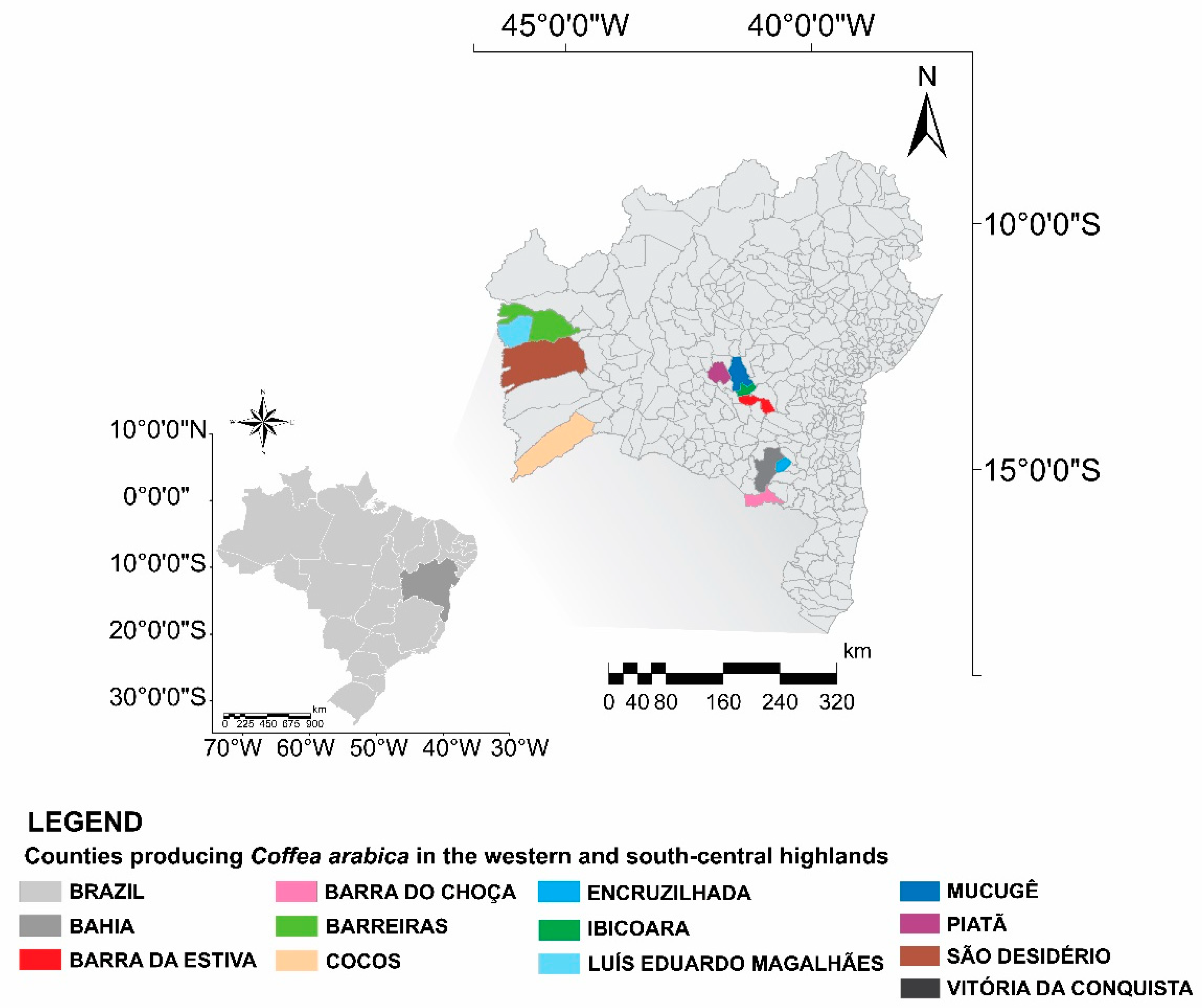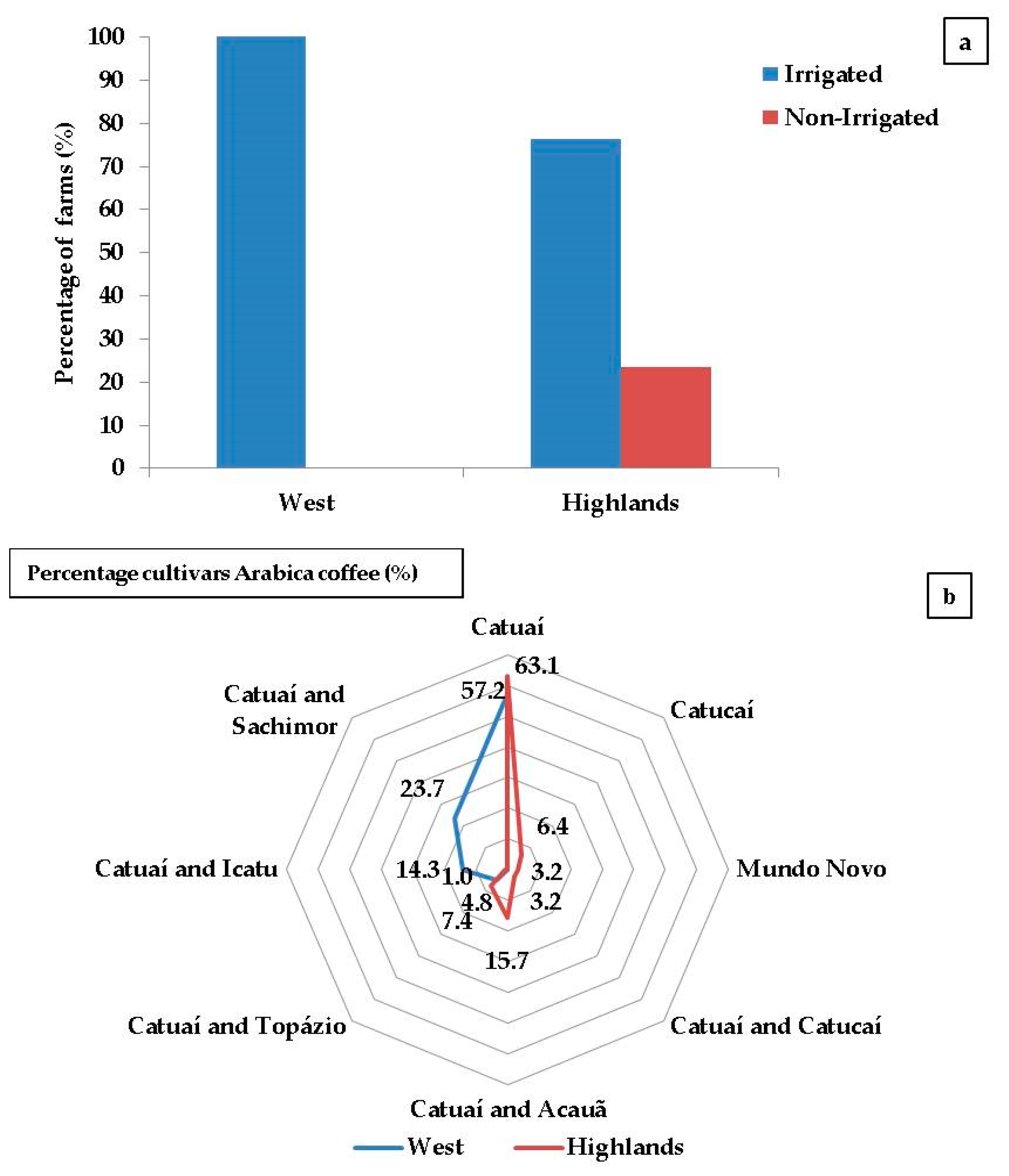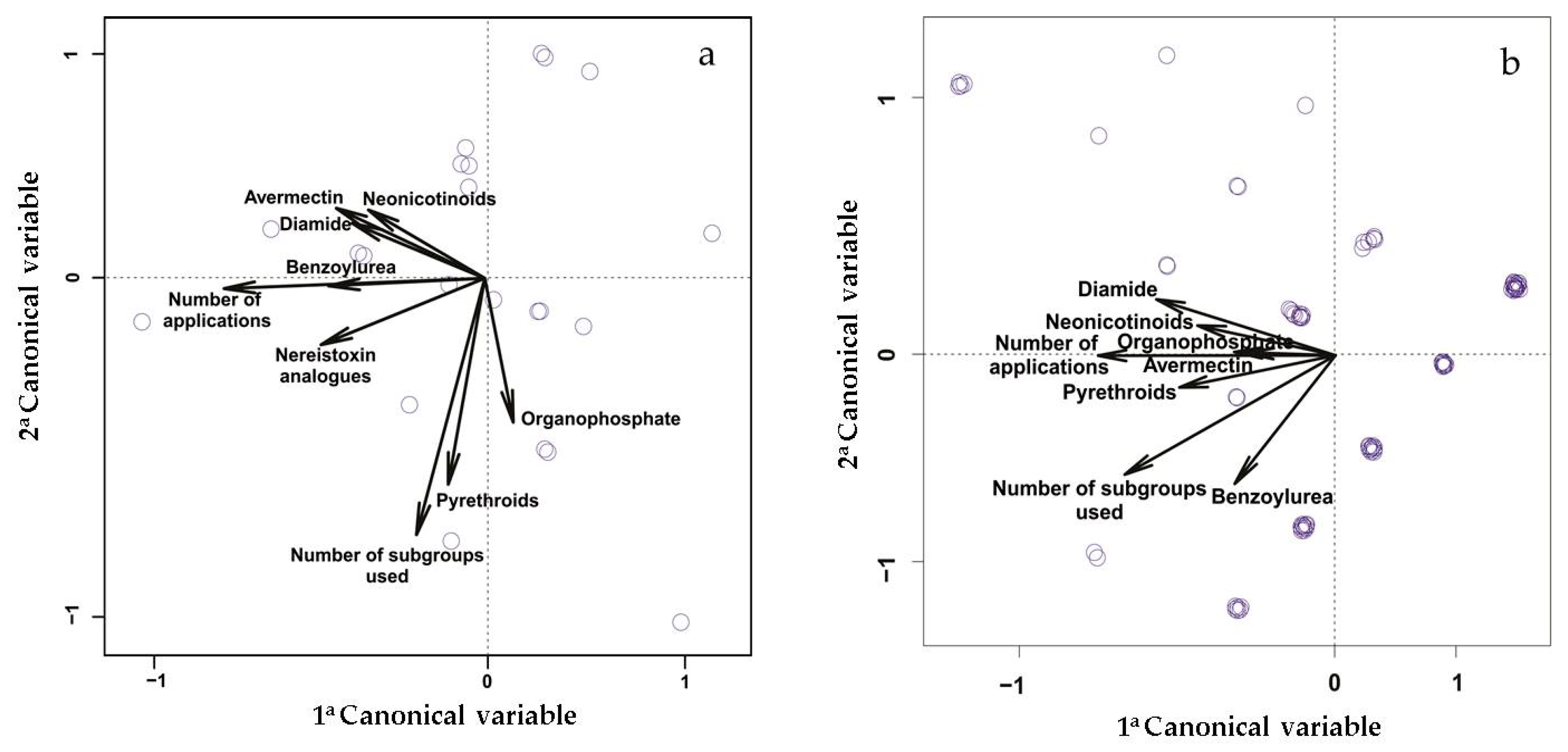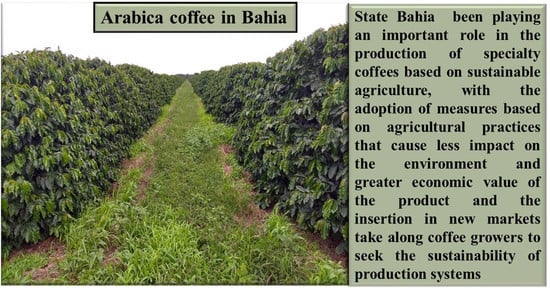Profile of Coffee Crops and Management of the Neotropical Coffee Leaf Miner, Leucoptera coffeella
Abstract
1. Introduction
2. Materials and Methods
2.1. Study Sites
2.2. Data Analysis
3. Results
4. Discussion
Author Contributions
Funding
Acknowledgments
Conflicts of Interest
References
- Righi, C.A.; Campoe, O.C.; Bernardes, M.S.; Lunz, A.M.P.; Piedade, S.D.S.; Pereira, C.R. Influence of rubber trees on leaf-miner damage to coffee plants in an agroforestry system. Agrofor. Syst. 2013, 87, 1351–1362. [Google Scholar] [CrossRef]
- CONAB; Companhia Nacional de Abastecimento. Acompanhamento da Safra Brasileira Café. Safra 2020, n.1–Primeiro Levantamento, ISSN 2318-7913, Brasília, Brazil. Available online: http://www.conab.gov.br (accessed on 30 May 2020).
- Castellani, M.A.; Melo, T.L.; Menezes, M.A.P. Desafios para o manejo do bicho-mineiro. Aiba Rural 2016, 5, 40–41. [Google Scholar]
- Świtek, S.; Sawińska, Z. Farmer rationality and the adoption of greening practices in Poland. Sci. Agric. 2017, 74, 275–284. [Google Scholar] [CrossRef]
- Sawińska, Z.; Świtek, S.; Głowicka-Wołoszyn, R.; Kowalczewski, P.L.; Głowicka-Wołoszyn, R. Agricultural practice in Poland before and after mandatory IPM implementation by the European Union. Sustainabillity 2020, 12, 1107. [Google Scholar] [CrossRef]
- Ha, T.M. A rewiev on the development of integrated pest management and its integration in modern agriculture. Asianj. Agricul. Food Sci. 2014, 2, 336–340. [Google Scholar]
- Dara, S.K. The new integrated pest management paradigm for the modern age. J. Integr. Pest. Manag. 2019, 10, 1–9. [Google Scholar] [CrossRef]
- Ehler, L. Integrated pest management (IPM): Definition, historical development and implementation, and the other IPM. Pest. Manag. Sci. 2006, 62, 787–789. [Google Scholar] [CrossRef]
- Zalucki, M.P.; Adamson, D.; Furlong, M.J. The future of IPM: Whither or wither? Aust. J. Èntomol. 2009, 48, 85–96. [Google Scholar] [CrossRef]
- Crocomo, W.B. Manejo Integrado de Pragas, 1st ed.; Editora Universidade Estadual Paulista: Botucatu, Brazil, 1990; p. 358. [Google Scholar]
- Guedes, R.N.C.; Tuelher, E.S.; De Oliveira, E.E.; Magalhães, L.C. Ocorrência de bicho-mineiro do cafeeiro (Leucoptera coffeella) influenciada pelo período estacional e pela altitude. Acta Sci. Agron. 2003, 25, 119–124. [Google Scholar] [CrossRef][Green Version]
- Pereira, E.J.G.; Picanço, M.; Bacci, L.; Crespo, A.; Guedes, R.N.C. Seasonal mortality factors of the coffee leaf miner, Leucoptera coffeella. Bull. Èntomol. Res. 2007, 97, 421–432. [Google Scholar] [CrossRef]
- Pereira, E.J.G.; Picanço, M.C.; Bacci, L.; Della Lucia, T.M.C.; Silva, É.M.; Fernandes, F.L. Natural mortality factors of Leucoptera coffeella (Lepidoptera: Lyonetiidae) on Coffea arabica. Biocontrol Sci. Technol. 2007, 17, 441–455. [Google Scholar] [CrossRef]
- Magalhães, S.; Fernandes, F.L.; Demuner, A.J.; Picanço, M.C.; Guedes, R.N.C. Leaf alkaloids, phenolics, and coffee resistance to the leaf miner Leucoptera coffeella (Lepidoptera: Lyonetiidae). J. Econ. Èntomol. 2010, 103, 1438–1443. [Google Scholar] [CrossRef]
- Pantoja-Gomez, L.M.; Correa, A.S.; De Oliveira, L.O.; Guedes, R.N.C. Common Origin of Brazilian and Colombian Populations of the Neotropical Coffee Leaf Miner, Leucoptera coffeella (Lepidoptera: Lyonetiidae). J. Econ. Èntomol. 2019, 112, 924–931. [Google Scholar] [CrossRef]
- Parra, J.R.P.; Reis, P.R. Manejo integrado para as principais pragas da cafeicultura, no Brasil. Visão Agrícola–Fitossanidade 2013, 12, 47–50. [Google Scholar]
- Enríquez, E.; Bejarano, S.; Vila, V. Morfología, ciclo biológico y comportamiento de Leucoptera coffeella. Guer.-Men. Rev. Per. Entomol. 1975, 18, 79–81. [Google Scholar]
- De Custódio, A.A.P.; Moraes, J.C.; de Custódio, A.A.P.; Lima, L.A.; de Faria, M.A.; Gomes, N.M. Incidência do bicho-mineiro do cafeeiro em lavoura irrigada sob pivô central. Coffee Sci. 2009, 4, 16–26. [Google Scholar]
- Fragoso, D.; Guedes, R.N.C.; Picanço, M.; Zambolim, L. Insecticide use and organophosphate resistance in the coffee leaf miner Leucoptera coffeella (Lepidoptera: Lyonetiidae). Bull. Èntomol. Res. 2002, 92, 203–212. [Google Scholar] [CrossRef]
- Ramiro, D.A.; Guerreiro-Filho, O.; Queiroz-Voltan, R.B.; Matthiesen, S.C. Caracterização anatômica de folhas de cafeeiros resistentes e suscetíveis ao bicho-mineiro. Bragantia 2004, 63, 363–372. [Google Scholar] [CrossRef]
- Gao, C.-F.; Su, J.; Yao, R.; Zhang, Z.; Wu, M. Susceptibility Baseline and Chlorantraniliprole Resistance Monitoring in Chilo suppressalis (Lepidoptera: Pyralidae). J. Econ. Èntomol. 2013, 106, 2190–2194. [Google Scholar] [CrossRef]
- Costa, D. Resistance to neurotoxic insecticides in populations of the coffee leafminer Leucoptera coffeella. In Insecticides Resistance; Intech Open: London, UK, 2016; pp. 3–17. [Google Scholar]
- Fragoso, D.B.; Guedes, R.N.C.; Ladeira, J.A. Seleção na evolução de resistência a organofosfatos em Leucoptera coffeella (Guérin-Mèneville) (Lepidoptera: Lyonetiidae). Neotrop. Entomol. 2003, 32, 329–334. [Google Scholar] [CrossRef]
- Ribeiro, B.M.; de Magalhães, L.C.; Guedes, R.N.C. Níveis de resistência a inseticidas organo-fosforados em populações de Leucoptera coffeella (Guèr-Ménev) (Lepidoptera: Lyonetiidae) de Minas Gerais. Biosc. J. 2003, 19, 73–77. [Google Scholar]
- Leite, S.A.; dos Santos, M.P.; Resende-Silva, G.A.; da Costa, D.R.; Moreira, A.A.; Lemos, O.L.; Guedes, R.N.C.; Castellani, M.A. Area-Wide Survey of Chlorantraniliprole Resistance and Control Failure Likelihood of the Neotropical Coffee Leaf Miner, Leucoptera coffeella (Lepidoptera: Lyonetiidae). J. Econ. Èntomol. 2020, 113, 1399–1410. [Google Scholar] [CrossRef]
- Lé, S.; Josse, J.; Husson, F. FactoMineR: An R Package for Multivariate Analysis. J. Stat. Softw. 2008, 25, 1–18. [Google Scholar] [CrossRef]
- Cruz-Jesus, F.; Oliveira, T.; Bação, F.; Irani, Z. Assessing the pattern between economic and digital development of countries. Inf. Syst. Front. 2016, 19, 835–854. [Google Scholar] [CrossRef]
- SAS Institute. SAS/STAT9.3 User’s Guide; SAS Institute: Cary, NC, USA, 2011. [Google Scholar]
- Ministério da Agricultura Pecuária e Abastecimento (MAPA). AGROFIT: Sistema de Agrotóxicos Fitossanitários. MAPA/CGAF/DFIA/DAS, Brasília, DF, Brasil 2020. Available online: http://agrofit.agricultura.gov.br/agrofit_cons/principal_agrofit_cons (accessed on 27 January 2020).
- De Freitas, Z.M.T.S.; De Oliveira, F.J.; De Carvalho, S.P.; Dos Santos, V.F.; Santos, J.P.D.O. Avaliação de caracteres quantitativos relacionados com o crescimento vegetativo entre cultivares de café arábica de porte baixo. Bragantia 2007, 66, 267–275. [Google Scholar] [CrossRef][Green Version]
- Fernandes, A.L.T.; Partelli, F.L.; Bonomo, R.; Golynski, A. A moderna cafeicultura dos cerrados brasileiros. Pesqui. Agropecuária Trop. 2012, 42, 231–240. [Google Scholar] [CrossRef]
- Bandeira, F.P. Café da Chapada Diamantina ganha o mundo. Secretária de Agricultura do Estado da Bahia 2017, 6–25. [Google Scholar]
- Picanço, M.C.; Martins, J.C.; Oliveira, I.R.; Martinez, H.E.P.; Milagres, C.C. Plano de Amostragem Convencional do Bicho Mineiro Através de Contagem de Minas com Lagartas e Cafeeiro em Formação. Anais do Simpósio de Pesquisa dos Cafés do Brasil, Londrina, Paraná. Embrapa Café, Brasília, Distrito Federal, Brazil. 2005, 4. Available online: http://www.sbicafe.ufv.br/handle/123456789/1873 (accessed on 21 May 2020).
- Vieira Neto, J.; Aquino, L.H.; Bearzoti, E.; Souza, J.C. Otimização da amostragem sequencial para o monitoramento do bicho-mineiro do cafeeiro Perileucoptera coffeella (Lepidoptera: Lyonetiidae) em Lavras, Minas Gerais. Cien. Agrotec. 1999, 23, 707–718. [Google Scholar]
- Picanço, M.C.; de Oliveira, I.R.; Fernandes, F.L.; Martinez, H.E.P.; Bacci, L.; da Silva, E.M. Ecology of vespidae (Hymenoptera) predators in Coffea arabica plantations. Sociobiology 2012, 59, 1269–1280. [Google Scholar]
- Souza, J.C.; Reis, P.R. Pragas do Cafeeiro–Reconhecimento e Controle; CTP: Viçosa, Brazil, 2000; p. 154. [Google Scholar]
- Picanço, M.C.; De Paula, S.V.; Junior, A.R.M.; De Oliveira, I.R.; Semeão, A.A.; Rosado, J.F. Impactos financeiros da adoção de manejo integrado de pragas na cultura do tomateiro. Acta Sci. Agron. 2004, 26, 245–252. [Google Scholar] [CrossRef]
- Alam, M.Z.; Crump, A.R.; Haque, M.; Islam, S.; Hossain, E.; Hasan, S.B.; Hasan, S.B.; Hossain, S. Effects of Integrated Pest Management on Pest Damage and Yield Components in a Rice Agro-Ecosystem in the Barisal Region of Bangladesh. Front. Environ. Sci. 2016, 4, 22. [Google Scholar] [CrossRef]
- Bortolotto, O.C.; Pomari-Fernandes, A.; Bueno, R.C.O.D.F.; Bueno, A.D.F.; Da Cruz, Y.K.; Sanzovo, A.; Ferreira, R.B. The use of soybean integrated pest management in Brazil: A review. Agron. Sci. Biotechnol. 2015, 1, 25–32. [Google Scholar] [CrossRef]
- Dhawan, A.K. Integrated pest management in cotton. In Integrated Pest Management in the Tropics; Dharam, P., Ed.; New India Publishing Agency: New Delhi, India, 2016; pp. 499–575. [Google Scholar]
- Bueno, A.D.F.; Batistela, M.J.; Bueno, R.C.; França-Neto, J.D.B.; Nishikawa, M.A.N.; Filho, A.L. Effects of integrated pest management, biological control and prophylactic use of insecticides on the management and sustainability of soybean. Crop. Prot. 2011, 30, 937–945. [Google Scholar] [CrossRef]
- Staback, D.; Blanck, P.L.; Mariussi, V.; Galante, V.A. Uso do MIP como estratégia de redução de custos na produção de soja no estado do Paraná. Rev. Am. Empr. Inov. 2020, 2, 187–200. [Google Scholar]
- Varela, D.; Monteiro, F.; Vidigal, P.; Silva, L.; Romeiras, M.M. Mechanisms implemented for the sustainable development of agriculture: An overview of Cabo Verde performance. Sustainability 2020, 12, 5855. [Google Scholar] [CrossRef]
- Melo, T.L.; Castellani, M.A.; Nascimento, M.D.L.D.; Junior, A.D.O.M.; Ferreira, G.F.P.; Lemos, O.L. Comunidades de parasitóides de Leucoptera coffeella (Guérin-Mèneville & Perrottet, 1842) (Lepidoptera: Lyonetiidae) em cafeeiros nas regiões Oeste e Sudoeste da Bahia. Ciência Agrotecnol. 2007, 31, 966–972. [Google Scholar] [CrossRef]
- Reis, P.R.; Souza, J.C.; Venzon, M. Manejo das principais pragas do cafeeiro. Informe Agropecuário 2002, 23, 83–99. [Google Scholar]
- Faria, S.C.Q.D.S.; Angelini, M.R. Influência do manejo de plantas daninhas na incidência do bicho-minerio Leucoptera coffeella (Guérin-Méneville, 1842) (Lepidoptera: Lyonetiidae) na Região do cerrado mineiro. Enciclopédia Biosf. 2015, 11, 2022–2027. [Google Scholar] [CrossRef]
- Amaral, D.S.; Venzon, M.; Pallini, A.; De Lima, P.C.; De Souza, O.F.F. A diversificação da vegetação reduz o ataque do bicho-mineiro-do-cafeeiro Leucoptera coffeella (Guérin-mèneville) (Lepidoptera: Lyonetiidae)? Neotrop. Èntomol. 2010, 39, 543–548. [Google Scholar] [CrossRef]
- Fragoso, D.B.; Jusselino-Filho, P.; Guedes, R.N.C.; Proque, R. Seletividade de inseticidas a vespas predadoras de Leucoptera coffeella (Guér.-Mènev.) (Lepidoptera: Lyonetiidae). Neotrop. Èntomol. 2001, 30, 139–143. [Google Scholar] [CrossRef]
- Souza, T.P.; Castellani, M.A.; de Lemos, R.N.S.; Pérez-Maluf, R.; Moreira, A.A.; Silva, B.S.; Ribeiro, E.B. Ocorrência sazonal, predação e parasitismo de Leucoptera coffeella (Guérin-Méneville, 1842) (Lepidoptera: Lyonetiidae) em cafeeiros associados a grevíleas. Coffee Sci. 2014, 9, 34–50. [Google Scholar]
- Melo, T.L.; Raetano, C.G.; Nery, M.S.; Cardoso, A.D.; Moreira, A.A.; Leite, S.A.; De Jesus, T.F.; Silva, W.G.O.; Castellani, M.A. Management of coffee leaf miner: Spray volume, efficacy of Cartap Hydrochloride and impact on parasitism. Coffee Sci. 2019, 14, 250–260. [Google Scholar] [CrossRef]
- Nauen, R.; Ebbinghaus-Kintscher, U.; Elbert, A.; Jeschke, P.; Tietjen, K. Acetylcholine Receptors as Sites for Developing Neonicotinoid Insecticides. In Biochemical Sites of Insecticide Action and Resistance; Springer Science and Business Media LLC: Berlin, Germany, 2001; pp. 77–105. [Google Scholar]
- Lahm, G.P.; Cordova, D.; Barry, J.D. New and selective ryanodine receptor activators for insect control. Bioorganic Med. Chem. 2009, 17, 4127–4133. [Google Scholar] [CrossRef] [PubMed]
- Ministério da Agricultura Pecuária e Abastecimento (MAPA). Sistema de Agrotóxicos Fitossanitários. MAPA/CGAF/DFIA/DAS, Certificado de Registro de Agrotóxico Avermectina com Finalidade http://agrofit.agricultura.gov.br/agrofit_cons/principal_agrofit_cons Fitossanitária para o Controle de Leucoptera coffeella, Brasília, DF, Brasil. 2008. Available online: http://agrofit.agricultura.gov.br/agrofit_cons/!ap_produto_form_detalhe_cons?p_id_produto_formulado_tecnico=5422&p_tipo_janela=NEW (accessed on 27 March 2020).
- Ministério da Agricultura Pecuária e Abastecimento (MAPA). Sistema de Agrotóxicos Fitossanitários. MAPA/CGAF/DFIA/DAS, Certificado de Registro de Agrotóxico Benzoilureia com Finalidade Fitossanitária para o Controle de Leucoptera coffeella, Brasília, DF, Brasil. 2009. Available online: grofit.agricultura.gov.br/agrofit_cons/!ap_produto_form_detalhe_cons?p_id_produto_formulado_tecnico=8918&p_tipo_janela=NEW (accessed on 27 March 2020).
- Georghiou, G.P. Management of Resistance in Arthropods; Springer Science and Business Media LLC: Berlin, Germany, 1983; pp. 769–792. [Google Scholar]
- Guedes, R.N.C.; Oliveira, E.E. Resistência a inseticidas-pragas do cafeeiro: Situação e perspectivas. In Oestado da Arte de Tecnologias na Produção de Café, 1st ed.; Zambolim, L., Ed.; UFV: Viçosa, Brazil, 2002; pp. 471–497. [Google Scholar]
- Fernandes, F.L.; Bacci, L.; Fernandes, M.S. Impact and selectivity of insecticides to predators and parasitoids. EntomoBrasilis 2010, 3, 1–10. [Google Scholar] [CrossRef]
- Oliveira, A.D.S.; Castellani, M.A.; Nascimento, A.S.D.; Moreira, A.A. Perfil do sistema de produção de pinha nos polos de fruticultura da Bahia, com ênfase nos aspectos fitossanitários da cultura. Extensão Rural 2016, 23, 95. [Google Scholar] [CrossRef]
- Visão 2030: O Futuro da Agricultura Brasileira; Embrapa: Brasília, Brazil, 2018; p. 212.





| Total Area | |||
|---|---|---|---|
| Component | Eigenvalues | Proportion | Proportion Accumulated |
| PC1 | 1.12 | 56.03 | 56.03 |
| PC2 | 0.87 | 43.96 | 100.00 |
| Cultivated Area | |||
| PC1 | 1.08 | 54.28 | 54.28 |
| PC2 | 0.91 | 45.71 | 100.00 |
| Native Vegetation Area | |||
| PC1 | 1.90 | 62.61 | 62.61 |
| PC2 | 0.89 | 37.39 | 100.00 |
| Variable | Canonical Axes | |||
|---|---|---|---|---|
| West | Highlands | |||
| 1 | 2 | 1 | 2 | |
| Diamide | 0.5070 | −0.1915 | 0.7548 | −0.2161 |
| Neonicotinoids | 0.4467 | −0.2930 | 0.5815 | −0.1152 |
| Pyrethroids | 0.1424 | −0.2875 | 0.6578 | 0.1237 |
| Avermectin | 0.5694 | 0.0037 | 0.3793 | −0.0096 |
| Benzoylurea | 0.5996 | 0.3062 | 0.4246 | 0.4954 |
| Organophosphate | −0.1109 | 0.6159 | 0.4268 | −0.0131 |
| Nereistoxin analogs | 0.6256 | 0.7459 | - | - |
| F | 140.96 | 12.43 | 338.29 | 8.70 |
| Degrees of Freedom (num.; den) | 14; 24 | 6; 13 | 12; 174 | 5; 88 |
| p | <0.0001 | <0.0001 | <0.0001 | <0.0001 |
| Canonical squared correlation | 0.99 | 0.85 | 0.99 | 0.33 |
© 2020 by the authors. Licensee MDPI, Basel, Switzerland. This article is an open access article distributed under the terms and conditions of the Creative Commons Attribution (CC BY) license (http://creativecommons.org/licenses/by/4.0/).
Share and Cite
Leite, S.A.; Guedes, R.N.C.; Santos, M.P.d.; Costa, D.R.d.; Moreira, A.A.; Matsumoto, S.N.; Lemos, O.L.; Castellani, M.A. Profile of Coffee Crops and Management of the Neotropical Coffee Leaf Miner, Leucoptera coffeella. Sustainability 2020, 12, 8011. https://doi.org/10.3390/su12198011
Leite SA, Guedes RNC, Santos MPd, Costa DRd, Moreira AA, Matsumoto SN, Lemos OL, Castellani MA. Profile of Coffee Crops and Management of the Neotropical Coffee Leaf Miner, Leucoptera coffeella. Sustainability. 2020; 12(19):8011. https://doi.org/10.3390/su12198011
Chicago/Turabian StyleLeite, Suzany Aguiar, Raul Narciso Carvalho Guedes, Mateus Pereira dos Santos, Daniela Ribeiro da Costa, Aldenise Alves Moreira, Sylvana Naomi Matsumoto, Odair Lacerda Lemos, and Maria Aparecida Castellani. 2020. "Profile of Coffee Crops and Management of the Neotropical Coffee Leaf Miner, Leucoptera coffeella" Sustainability 12, no. 19: 8011. https://doi.org/10.3390/su12198011
APA StyleLeite, S. A., Guedes, R. N. C., Santos, M. P. d., Costa, D. R. d., Moreira, A. A., Matsumoto, S. N., Lemos, O. L., & Castellani, M. A. (2020). Profile of Coffee Crops and Management of the Neotropical Coffee Leaf Miner, Leucoptera coffeella. Sustainability, 12(19), 8011. https://doi.org/10.3390/su12198011









